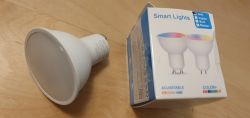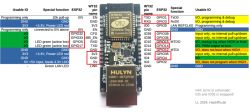Hi, maybe someone can give a hint - the ESP8266 chip in the ESP-12F version on the Wemos D1 mini PCB is not responding to AT commands.
Uploaded ESP8266_NONOS_SDK-1.5.4 firmware (works at 74880), the chip works fine, you can upload a program to it and execute, but it doesn't respond to AT commands sent (maybe I'm doing something wrong or misconfiguring the terminal)?
I would like to add that I have tried on different terminals with CR=CR+LF transmission enabled, Handshaking - none, etc., while receiving data that is what the chip sends correctly displays on the terminal....
Uploaded ESP8266_NONOS_SDK-1.5.4 firmware (works at 74880), the chip works fine, you can upload a program to it and execute, but it doesn't respond to AT commands sent (maybe I'm doing something wrong or misconfiguring the terminal)?
I would like to add that I have tried on different terminals with CR=CR+LF transmission enabled, Handshaking - none, etc., while receiving data that is what the chip sends correctly displays on the terminal....








